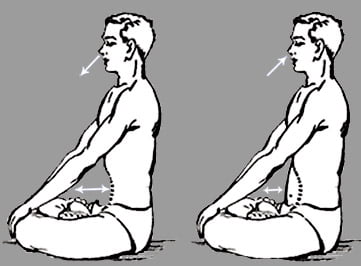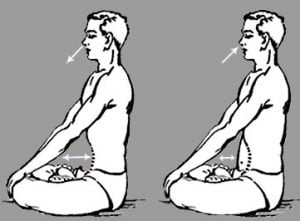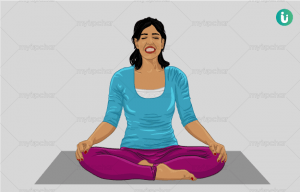Pranayam
Let’s enhance the quality of our day by sprinkling a little bit of Pranayam in it!
Kapalbhati Pranayam
Kapalbhati is the last of the six shatkarma in fact in the gheranda samhita it is also known as Bhalabhati.
- Bhala and Kapal means the cranium or forehead wherein Bhati is light or splendour, but it also mean perception and knowledge.
- Kapalbhati is a pranayam technique which invigorates the entire brain and hence awakens the dormant centres which are responsible for subtle perception.
- It is called the frontal brain cleansing technique.
There are three form of kapalbhati according to gheranda samhita, those are:- vatakarma, vyutkarma, and sheetkarma. Hatha yoga pradipika describes only Vatkarma wherein Vata means wind or air.
Technique 1 Vatkarma Kapalbhati
- Sit in a comfortable meditative pose ,preferably siddhasana / siddha yoni asana and prepare yourself for meditation.
- Close the eyes and relax, keeping the spire erect.
- Place the hands in either jnana or chin mudra.
- Practice kaya sthairyam, i.e. steadiness of the body.
- Inhale deeply and perform fifty fast respirations through both nostrils placing more emphasis on exhalation.
- Inhalation should be short.
- After the last exhalation, inhale deeply through the nose and exhale quickly through the mouth, slightly pursing the lips.
- With kambhaka, perform jalandhara bandh, moolabandh and uddiyana bandh in this order, but almost simultaneously.
- Maintain the kumbhaka and bandhas for as long as possible and count the duration.
- Before inhaling, release moola bandha then uddiyana and then Jalandhar in this order.
- When the head is raised, inhale slowly through the nose. Practice three rounds of fifty breaths.
- When this is perfected you can increase it to five rounds.
- You can increase the practice by ten breaths each week. So that after five weeks you are performing 100 breaths per round.
- After completing the practice concentrate on the space in front of the close eyes.
Kapalbhati is best to do before concentration or meditation and after asana or neti. If you experience dizziness while practising, it indicates you are breathing too forcefully and if this is the case, stop practising and sit quietly for a few moments. When you begin to practice again do it with more awareness, and with less force. The efforts of kapalbhati and bhastrika are similar, but due to the forced and long exhalation, kapalbhati affects the brain differently.
Here’s a video link for more clarity !

Bhastrika Pranayam
Breath in and out forcefully through the nostrils filling and emptying the abdomen like the bellows of a blacksmith. Repeat this twenty times then hold the breath. The learned ones have named it bhastrika kumbhaka, it is recommended to practice thrice and by practising it a disease free state is easier to maintain day by day.
Technique:
In this pranayam inhalation and exhalation is rapidly performed at the same ratio, like a bellows of a blacksmith. Here sage gheranda samhita only gives instructions for breathing through both nostrils twenty times and then exhaling and practicing kumbhaka. This process of rhythmic breathing in and out of the nose is performed quickly it is not instructed here to practice with one nostril but in the next stage of the practice it is taught that the breath is forcibly taken in through the left nostril and released quickly twenty times, after this with the twenty first breath drawn in kumbhaka is performed. The same sequence is followed using the right nostril and then through both nostril together, making one round, maintaining kumbhaka as long as possible without straining. When learning bhastrika, the technique has to be first perfected with internal retention. When the breath can not be retained internally any longer, it is slowly released through the same nostril. In other texts the use of both jalandhara bandha and moola bandha together.
Awareness:
Focus the awareness on the breathing process, the physical movement of the abdomen and the mental counting.
Contra-indications :
Bhastrika should not be practised by people who suffer from high blood pressure, heart disease, hernia, gastric ulcer, stroke, epilepsy, retinal problems, glaucoma or vertigo.
Benefits:
This practice burns up toxins and removes diseases of the doshas of humors kapha (phalgum), pitta (bile) and vata (wind). The practice purifies the blood and its very helpful for skin diseases and heeling wounds, boils etc. It balances the strengthens the nervous system
Here’s a video link for more clarity !

Sheetkari Pranayam
In sheetkari pranayam the sound ‘see’ and ‘seet’ is made during inhalation. The Sanskrit word kari means that which produces, the practice produce the sound ‘see’ and it also produce coolness. In English this practice is usually called “the hissing breath”.
Technique 1:
- Sit in the comfortable meditative pose ,preferably siddhasana/siddha yoni asana and close your eyes.
- Keep the hands on the knees throughout the practise in either jnana or chin mudra.
- Practice kaya sthairyam for a minute or so.
- Press the lower and upper teeth together and separate the lips as much as is comfortable.
- Breath in slowly through the gaps in the teeth.
- Listen to the sound of the breath as air is drawn in.
- Close the mouth at the end of inhalation and slowly exhale through the nose.
- Repeat the same process up to twenty times.
Benefits:
Sheetkari cools the body should therefore be practised during warm season, not in winter unless particularly specified by your guru. If the weather is extremely hot it can be practised for more than 10 minutes. Yogi swatmarama mentions that the practitioner of sheetkari becomes kaamadeva the second when they practice it. In Hindu mythology kaamadeva is the god of love and passion.
Here’s a video link for more clarity !

Do read our other articles! We are sure you’ll find something useful in there ! Click here to land in our BLOG section.
प्राणायाम
आइए थोड़ा सा प्राणायाम छिड़क कर अपने दिन की गुणवत्ता को बढ़ाएं!
कपालभाती
छह षट्कर्मों में से अंतिम षट्कर्म कपालभाति है ।घेरंडा संहिता में इसे भालभाति के नाम से जाना जाता है।
- भाला और कपाल का अर्थ है कपाल या माथा। भाटी प्रकाश या वैभव है, लेकिन इसका अर्थ धारणा और ज्ञान भी है।
- कपालभाति एक प्राणायाम तकनीक है जो पूरे मस्तिष्क को सक्रिय करती है और उन निष्क्रिय केंद्रों को जगाती है जो सूक्ष्म धारणा के लिए जिम्मेदार हैं।
- अंग्रेजी में इसे फ्रंटल ब्रेन क्लींजिंग तकनीक कहते हैं।
घेरंडा संहिता के अनुसार कपालभाति के तीन रूप हैं: वातकर्म, व्युत्कर्म और शीतकर्म। हठ योग प्रदीपिका केवल वटकर्म का वर्णन करती है। वात का अर्थ है हवा या हवा।
तकनीक १ वटकर्म कपालभाति
- एक आरामदायक ध्यान मुद्रा में बैठें, अधिमानतः सिद्धासन / सिद्ध योनि आसन और ध्यान के लिए खुद को तैयार करें।
- आंखें बंद करें और शिखर को सीधा रखते हुए आराम करें।
- हाथों को या तो ज्ञान या ठोड़ी मुद्रा में रखें।
- काया स्थैर्यम् अर्थात शरीर की स्थिरता का अभ्यास करें ।
- गहरी सांस लें और सांस छोड़ने पर अधिक जोर देते हुए दोनों नथुनों से पचास तेज सांसें लें।
- साँस लेना छोटा होना चाहिए।
- अंतिम साँस छोड़ने के बाद, नाक से गहरी साँस लें और मुँह से जल्दी से साँस छोड़ें, होठों को थोड़ा सा शुद्ध करें।
- कम्बक के साथ , इस क्रम में जालंधर बंद , मूलबंध और उड़ियाना बंद करें, लेकिन लगभग एक साथ।
- बनाए रखें kumbhaka और bandhas जब तक संभव हो के लिए और अवधि गिनती।
- सांस लेने से पहले मूल बंध फिर उड़ियाना और फिर जालंधर को इसी क्रम में छोड़ दें।
- जब सिर ऊपर उठे तो नाक से धीरे-धीरे सांस लें। पचास श्वासों के तीन चक्रों का अभ्यास करें।
- जब यह सिद्ध हो जाए तो आप इसे पांच राउंड तक बढ़ा सकते हैं।
- आप अभ्यास को हर हफ्ते दस सांसों तक बढ़ा सकते हैं। ताकि पांच सप्ताह के बाद आप प्रति चक्कर 100 बार सांस ले रहे हों।
- अभ्यास पूरा करने के बाद बंद आँखों के सामने की जगह पर ध्यान केंद्रित करें।
कपालभाति आसन या नेति के बाद की जानी चाहिए , लेकिन एकाग्रता या ध्यान से पहले।
यदि आप अभ्यास करते समय चक्कर आना अनुभव करते हैं। इसका मतलब है कि आप बहुत जोर से सांस ले रहे हैं। यदि ऐसा है, तो अभ्यास बंद कर दें और कुछ क्षण शांत बैठें। जब आप फिर से अभ्यास करना शुरू करते हैं तो इसे अधिक जागरूकता के साथ और कम बल के साथ करें। के प्रयासों कपालभाति और भस्त्रिका समान है, लेकिन मजबूर और लंबी साँस छोड़ना के कारण होते हैं, कपालभाति अलग ढंग से मस्तिष्क को प्रभावित करता।
यहाँ अधिक स्पष्टता के लिए एक वीडियो लिंक है!

भस्त्रिका
लोहार की धौंकनी की तरह पेट को दोनों नथुनों से भरकर और खाली करके जोर से सांस अंदर और बाहर करें। इसे बीस बार दोहराएं फिर सांस को रोककर रखें। विद्वानों ने इसका नाम भस्त्रिका कुम्भक रखा है, इस प्रकार तीन बार इसका अभ्यास करने से कोई रोग या विकार नहीं होता और दिन-प्रतिदिन रोग/मुक्त अवस्था में वृद्धि होती है।
तकनीक:-
इस प्राणायाम में एक लोहार की धौंकनी की तरह साँस लेना और छोड़ना एक ही अनुपात में तेजी से किया जाता है। यहां घेरंडा संहिता में ऋषि केवल बीस बार दोनों नथुनों से सांस लेने और फिर सांस छोड़ने और कुंभक का अभ्यास करने का निर्देश देते हैं । नाक के अंदर और बाहर लयबद्ध श्वास लेने की यह प्रक्रिया शीघ्रता से की जाती है, यहां एक नथुने से अभ्यास करने का निर्देश नहीं दिया गया है, लेकिन अभ्यास के अगले चरण में यह सिखाया जाता है कि श्वास को बाएं नथुने से जबरन अंदर लिया जाता है और बीस जल्दी छोड़ दिया जाता है इसके बाद इक्कीसवीं सांस लेकर कुंभक में प्रदर्शन किया जाता है।
यही क्रम दायीं नासिका छिद्र से और फिर दोनों नथुनों से एक साथ मिलाकर एक चक्कर लगाकर , कुम्भक को यथासंभव लंबे समय तक बिना तनाव के बनाए रखा जाता है।
भस्त्रिका सीखते समय , तकनीक को पहले आंतरिक प्रतिधारण के साथ सिद्ध करना होता है। जब श्वास को आंतरिक रूप से अधिक समय तक नहीं रखा जा सकता है, तो इसे धीरे-धीरे उसी नथुने से छोड़ा जाता है। अन्य ग्रंथों में जालंधर बंध और मूल बंध दोनों का एक साथ उपयोग किया गया है।
जागरूकता:-
सांस लेने की प्रक्रिया, पेट की शारीरिक गति और मानसिक गिनती पर ध्यान केंद्रित करें।
विपरीत संकेत:-
उच्च रक्तचाप, हृदय रोग, हर्निया, गैस्ट्रिक अल्सर, स्ट्रोक, मिर्गी, रेटिना की समस्या, ग्लूकोमा या चक्कर से पीड़ित लोगों को भस्त्रिका का अभ्यास नहीं करना चाहिए।
लाभ:-
यह अभ्यास विषाक्त पदार्थों को जलाता है और कफ (फाल्गम), पित्त (पित्त) और वात (हवा) के दोषों के रोगों को दूर करता है । यह अभ्यास रक्त को शुद्ध करता है और त्वचा रोगों और घाव, फोड़े आदि के लिए बहुत उपयोगी है। यह शांति, शांति और ध्यान के लिए दिमाग की तैयारी सहित तंत्रिका तंत्र को मजबूत करता है।
यहाँ अधिक स्पष्टता के लिए एक वीडियो लिंक है!

शीतकारी प्राणायाम
शीतकारी प्राणायाम में श्वास के दौरान ‘देखें’ और ‘सीत’ ध्वनि बनती है। संस्कृत शब्द कारी का अर्थ है कि जो उत्पन्न करता है, अभ्यास से ‘देखें’ ध्वनि उत्पन्न होती है और यह शीतलता भी उत्पन्न करती है। अंग्रेजी में इस अभ्यास को आमतौर पर “हिसिंग ब्रीथ” कहा जाता है।
तकनीक 1:-
- आरामदायक ध्यान मुद्रा में बैठें, अधिमानतः सिद्धासन / सिद्ध योनि आसन और अपनी आँखें बंद करें।
- अभ्यास के दौरान हाथों को घुटनों पर रखें या तो ज्ञान या ठुड्डी मुद्रा में रखें ।
- एक या दो मिनट के लिए काया स्थिरम का अभ्यास करें।
- निचले और ऊपरी दांतों को एक साथ दबाएं और जितना हो सके होंठों को अलग करें।
- दांतों के गैप से धीरे-धीरे सांस लें।
- जैसे ही हवा अंदर खींची जाती है, सांस की आवाज सुनें।
- श्वास के अंत में मुंह बंद करें और धीरे-धीरे नाक से सांस छोड़ें।
- यही प्रक्रिया बीस बार तक दोहराएं।
लाभ:-
शीतकारी का अभ्यास शरीर को शीतलता प्रदान करता है इसलिए गर्मी के मौसम में अभ्यास करना चाहिए, सर्दियों में नहीं जब तक कि आपके गुरु द्वारा विशेष रूप से निर्दिष्ट नहीं किया गया हो ।
यदि मौसम अत्यधिक गर्म हो तो इसका अभ्यास 10 मिनट से अधिक समय तक किया जा सकता है। योगी आत्माराम का उल्लेख है कि जब वे इसका अभ्यास करते हैं तो शीटकारी का अभ्यास करने वाला दूसरा कामदेव बन जाता है।
हिंदू पौराणिक कथाओं में कामदेव प्रेम और जुनून के देवता हैं।
यहाँ अधिक स्पष्टता के लिए एक वीडियो लिंक है!

Suman Thapliyal
Student
I am Suman Thapliyal (Siya Thapliyal)
I am pursuing Bsc yoga science and holistic health from Swami Rama Himalayan University (jolly grant)
I am also a writer and vlogger by my hobby……


Explore new worlds and face exciting challenges Lucky Cola
Gaming goals Achieve greatness, one level at a time Lodibet